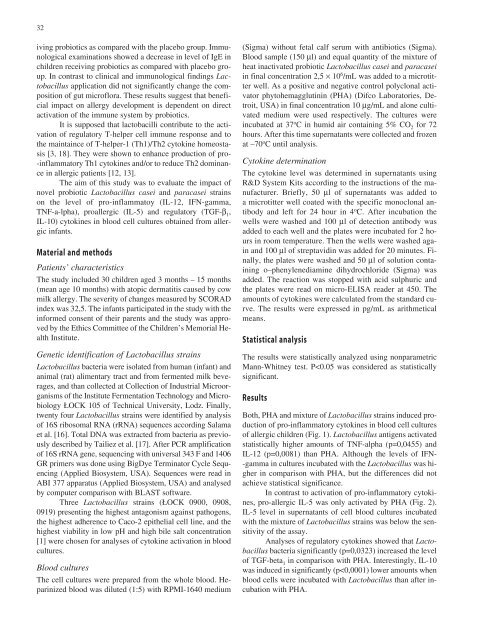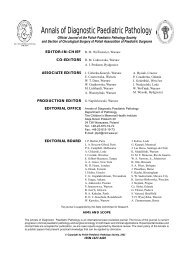annals 1-2.qxd - Centrum Zdrowia Dziecka
annals 1-2.qxd - Centrum Zdrowia Dziecka
annals 1-2.qxd - Centrum Zdrowia Dziecka
Create successful ePaper yourself
Turn your PDF publications into a flip-book with our unique Google optimized e-Paper software.
32<br />
iving probiotics as compared with the placebo group. Immunological<br />
examinations showed a decrease in level of IgE in<br />
children receiving probiotics as compared with placebo group.<br />
In contrast to clinical and immunological findings Lactobacillus<br />
application did not significantly change the composition<br />
of gut microflora. These results suggest that beneficial<br />
impact on allergy development is dependent on direct<br />
activation of the immune system by probiotics.<br />
It is supposed that lactobacilli contribute to the activation<br />
of regulatory T-helper cell immune response and to<br />
the maintaince of T-helper-1 (Th1)/Th2 cytokine homeostasis<br />
[3, 18]. They were shown to enhance production of pro-<br />
-inflammatory Th1 cytokines and/or to reduce Th2 dominance<br />
in allergic patients [12, 13].<br />
The aim of this study was to evaluate the impact of<br />
novel probiotic Lactobacillus casei and paracasei strains<br />
on the level of pro-inflammatoy (IL-12, IFN-gamma,<br />
TNF-a-lpha), proallergic (IL-5) and regulatory (TGF-β 1 ,<br />
IL-10) cytokines in blood cell cultures obtained from allergic<br />
infants.<br />
Material and methods<br />
Patients’ characteristics<br />
The study included 30 children aged 3 months – 15 months<br />
(mean age 10 months) with atopic dermatitis caused by cow<br />
milk allergy. The severity of changes measured by SCORAD<br />
index was 32,5. The infants participated in the study with the<br />
informed consent of their parents and the study was approved<br />
by the Ethics Committee of the Children’s Memorial Health<br />
Institute.<br />
Genetic identification of Lactobacillus strains<br />
Lactobacillus bacteria were isolated from human (infant) and<br />
animal (rat) alimentary tract and from fermented milk beverages,<br />
and than collected at Collection of Industrial Microorganisms<br />
of the Institute Fermentation Technology and Microbiology<br />
£OCK 105 of Technical University, Lodz. Finally,<br />
twenty four Lactobacillus strains were identified by analysis<br />
of 16S ribosomal RNA (rRNA) sequences according Salama<br />
et al. [16]. Total DNA was extracted from bacteria as previously<br />
described by Tailiez et al. [17]. After PCR amplification<br />
of 16S rRNA gene, sequencing with universal 343 F and 1406<br />
GR primers was done using BigDye Terminator Cycle Sequencing<br />
(Applied Biosystem, USA). Sequences were read in<br />
ABI 377 apparatus (Applied Biosystem, USA) and analysed<br />
by computer comparison with BLAST software.<br />
Three Lactobacillus strains (£OCK 0900, 0908,<br />
0919) presenting the highest antagonism against pathogens,<br />
the highest adherence to Caco-2 epithelial cell line, and the<br />
highest viability in low pH and high bile salt concentration<br />
[1] were chosen for analyses of cytokine activation in blood<br />
cultures.<br />
Blood cultures<br />
The cell cultures were prepared from the whole blood. Heparinized<br />
blood was diluted (1:5) with RPMI-1640 medium<br />
(Sigma) without fetal calf serum with antibiotics (Sigma).<br />
Blood sample (150 µl) and equal quantity of the mixture of<br />
heat inactivated probiotic Lactobacillus casei and paracasei<br />
in final concentration 2,5 × 10 6 /mL was added to a microtitter<br />
well. As a positive and negative control polyclonal activator<br />
phytohemagglutinin (PHA) (Difco Laboratories, Detroit,<br />
USA) in final concentration 10 µg/mL and alone cultivated<br />
medium were used respectively. The cultures were<br />
incubated at 37 o C in humid air containing 5% CO 2 for 72<br />
hours. After this time supernatants were collected and frozen<br />
at –70 o C until analysis.<br />
Cytokine determination<br />
The cytokine level was determined in supernatants using<br />
R&D System Kits according to the instructions of the manufacturer.<br />
Briefly, 50 µl of supernatants was added to<br />
a microtitter well coated with the specific monoclonal antibody<br />
and left for 24 hour in 4 o C. After incubation the<br />
wells were washed and 100 µl of detection antibody was<br />
added to each well and the plates were incubated for 2 hours<br />
in room temperature. Then the wells were washed again<br />
and 100 µl of streptavidin was added for 20 minutes. Finally,<br />
the plates were washed and 50 µl of solution containing<br />
o–phenylenediamine dihydrochloride (Sigma) was<br />
added. The reaction was stopped with acid sulphuric and<br />
the plates were read on micro-ELISA reader at 450. The<br />
amounts of cytokines were calculated from the standard curve.<br />
The results were expressed in pg/mL as arithmetical<br />
means.<br />
Statistical analysis<br />
The results were statistically analyzed using nonparametric<br />
Mann-Whitney test. P

















